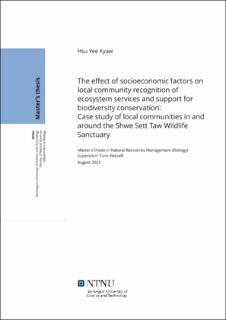| dc.description.abstract | Protected Areas (PA) were established for conservation purposes in the past, later inevitably integrated into the local community residing in and around those areas for a certain period of time. One of the most important advantages of establishing PA was the ability to maintain a specific ecosystem and its services for the well-being of people living in the vicinity. The availability and support of ecosystem services are critically important not only for the daily life and long-term sustainable conditions of local communities. Due to the ease of access and natural existence, ecosystem services (ESs) are not quite easy to notice for local communities apart from some prominent benefits obtained from PA. The recognition of local communities on the contribution of ESs by PA and their importance is extremely crucial for the long-term existence of PA and its biodiversity. In this study, the influencing factors on the utilization and perception of ESs were firstly assessed using three theoretical concepts of ES; provisioning, regulating, and cultural services contributed from PA, then the effect of those perceptions on the support of conservation was further evaluated. The study will be conducted as a questionnaire survey in every 24 households of 10 sample villages around the Shwe Sett Taw Wildlife Sanctuary (SSTWS). Socio-economic and demographic factors of local communities showed significant effects on how they utilized ESs and recognize the value of ESs. The linkage of perception on the ESs and personal attachment have interestingly revealed the importance of PA and conservation for their locality although there were some unfavorable factors. The recognition of ESs was less likely to relate with the distance from PA which means those who lived far from PA might also have high awareness of ESs (especially intangible benefits), and it differed from the ordinary benefits they used to obtain. The conservation support of local communities was normally related to their contact with PA and staff, interest and willingness to participate in conservation, and their conservation knowledge.
Keywords: perception, recognition, utilization, ecosystem services, conservation support, protected area, socio-economic, Shwe Sett Taw | |
